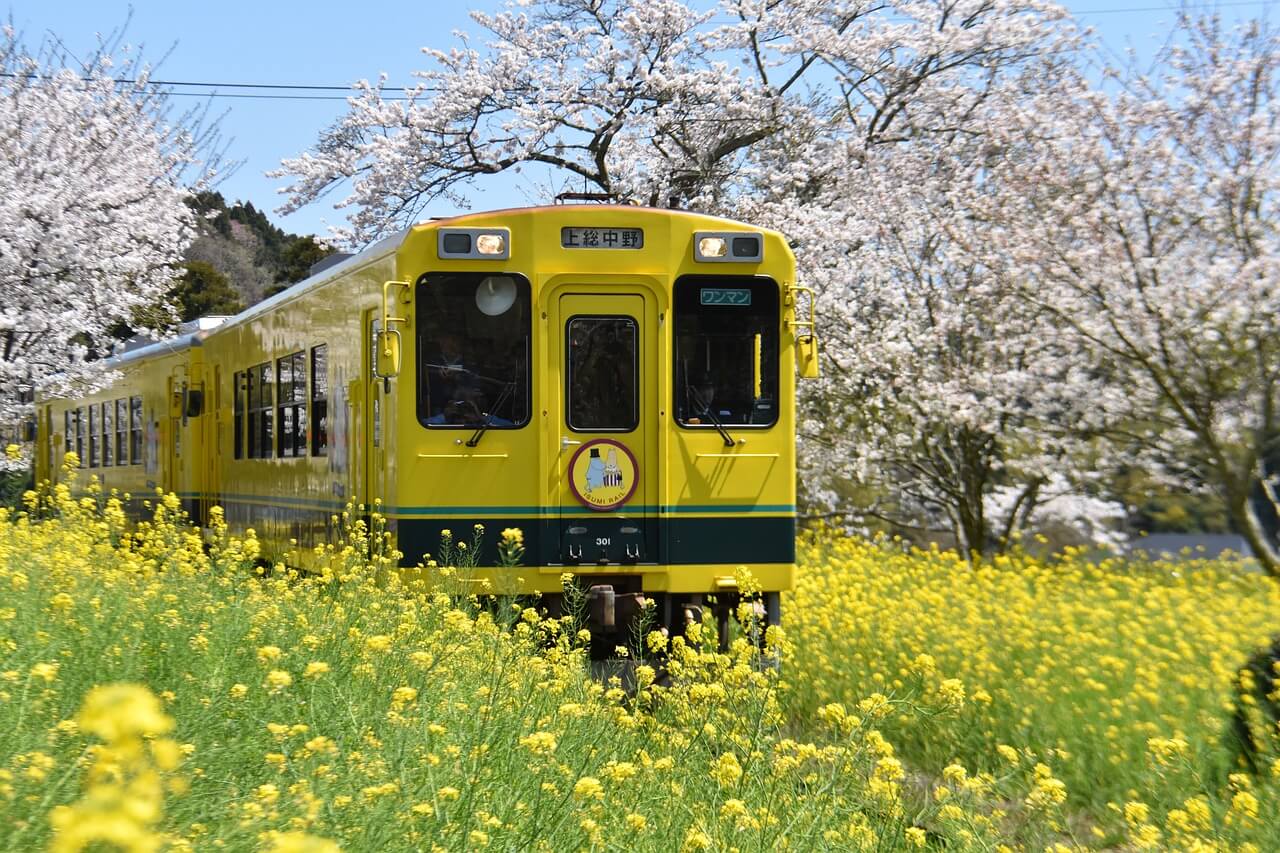From local and express trains to shinkansen and subways, train travel in Japan can get complicated fast. Thankfully there are now plenty of English resources like translated ticket machine menus and navigation apps. But even with those weapons at your disposal, you might still stumble.
To make your trip (or your life) in Japan easier, take a page from this… page… and set yourself up for success.
Types of Trains in Japan (In Order of Expense)
In a country that’s basically covered in railway tracks, there are more trains than you can imagine. And when you link them all up, they’ll take you almost anywhere in the country.
Here are the general types of trains that you’ll be riding in Japan.
Local Trains and Subways
The most common trains in Japan are local trains, running all over the countryside and most cities. They’re also usually the cheapest along with subways like Tokyo’s Metro which only run in the biggest cities.

Photo by TopoloGiraffe
Ticket prices for these trains can be as cheap as ¥100 for shorter journeys. If you’re lucky, you can also try to hunt one down with your favorite anime theme.
Express and Special Express Trains
Somewhere between local trains and bullet trains on the speed scale are special express trains. Okay, maybe they’re a lot closer in speed to local trains, but they’re still notably faster and require reserved seats.
There are a handful of these trains running in every prefecture and city. They often cost twice as much as a regular train ticket, but the trains themselves are quicker and they don’t make as many stops, so you get what you pay for.
Sleeper Trains
Classy. Intriguing. Nearly extinct. Sleeper trains aren’t so in style these days, but you can still catch them if you want to take the path less traveled. You’ll have to choose what type of bed you want when booking, so prices can vary. You can read more about Japan’s slowly disappearing overnight trains in a previous article.
Shinkansen
The one you’ve all been waiting for. Japan is famous for its bullet trains, releasing some undeniably stylish ones over the years. But to ride one, you’ll have to pony up, as tickets for high speed trains don’t come cheap, and the process for purchasing them can be difficult, too.

Image by Katherine_Lawrence
But once you’re on them, it can feel like you’re riding a low-flying airplane as they reach up to 320 km per hour. They’re also super comfy on the inside and have upgraded seat options, snack vendors, and even smoking rooms.
Train Ticket Prices in Japan
You can read more about how much the above trains cost in a previous article, but here’s a rough breakdown based on some common routes.
| Train Type | Route | Cost (¥) |
| Local | Kyoto station → Shin Osaka station | ¥570 |
| Subway | Shibuya → Ueno station (Tokyo) | ¥200 |
| Express | Kyoto station → Shin Osaka station | ¥1,230 |
| Shinkansen | Tokyo → Kyoto | ¥13,320 |
| Sleeper Train | Tokyo → Takamatsu | ¥15,370 and up (depending on seat type) |
The Tokyo to Kyoto bullet train is one of the most common routes for tourists, but if you really wanted to take the bullet train a little further, the same train from Tokyo to Osaka would be ¥13,870 instead of ¥13,320.
How to Pay for the Train
So you know how much a train costs. Now what?
To get those hot lil tickets, you’ll need to choose one of several payment methods.
The Japan Rail Pass
We’ll start with this one as it’s what most tourists to the country are looking for. The JR Pass is a one-time payment pass that not only makes train travel easier in Japan, it can make it cheaper, too.

You can set the pass for overseas visitors up via several online vendors, and bear in mind that it’s a little cheaper to order it from your home country rather than buying it after arrival in Japan (which you can also do). Here are the most common options that offer nearly country-wide railway access:
- 7-day pass: ¥29,650 (¥14,820 for kids)
- 14-day pass: ¥47,250 (¥23,620 for kids)
- 21-day pass: ¥ 60,450 (¥30,220 for kids)
Going from Tokyo to Osaka and back by shinkansen during a 1-week trip means that the Japan rail pass price will almost definitely be worth it. There are also several other versions of the pass like the many Tokyo-specific passes.
Ticket Machines
If you’re unsure whether a JR Pass would be worth it for your trip (try a train fare calculator to find out), you may choose to pay via ticket machines instead. The process is relatively simple, especially since they have English menus now.
You can usually choose the destination on these menus, so you can punch in, say, Umeda station in Osaka and it will automatically calculate the fare. You can also look at the station maps on the wall for your destination and the fare will be listed underneath. Pop the cash into the machine and out comes your ticket.
IC Cards
To avoid paper cuts, go with an integrated circuit card. You can get them at major train stations and add cash to them at ticketing machines. After that, you won’t need to even think about train fares anymore as you simply tap the card at turnstiles before moving through.

There are several versions of the IC card that give different benefits (including things like shopping discounts) and a few rules that go along with them. We’ve covered all of that in a previous article on Japan’s cash-charge cards for trains.
Japan’s Train Scheduling Apps and Websites
Knowing the rough price of a train trip and how to pay for it is helpful, but at some point we all need a little help.
There are plenty of apps and websites out there that make riding trains a lot easier. Some help with navigation and telling you train times while others are digital versions of the IC card, like the Suica app.
You don’t need to stuff your phone full of apps, but getting one or two from our list of helpful train apps will make your time zipping around Japan a lot easier.
Japanese Train Etiquette
Finally, we come to what to do and what not to do on a train in Japan. Like the rest of the country’s culture in general, there are rules to be aware of. Here are just a few:

- Form an orderly line on the train platform while waiting (there are often lines painted on the ground for you to stay inside of).
- Stand clear of the doors and wait for any passengers to get off before you board the train.
- Try to avoid loud/rowdy conversation, either with a fellow passenger or on the phone.
- Don’t take up priority seating (they’re usually marked in both Japanese and English)
- Some subway systems will have female-only train cars (these will also be clearly marked in both Japanese and English). Avoid these if you’re male.
- This one is a COVID-specific rule, but anyone riding the train is expected to wear a mask.
How Long Does It Take to Travel Around Japan by Train?
Train travel time in Japan depends on the type of train you use, but if you’re traveling between prefectures, you’ll probably ride a bullet train. A shinkansen from Tokyo to Kyoto, for example, would take a little over two hours. Continuing on to Hiroshima would be another two hours.
Local trains, subways, and express trains are much slower, but as the distances are also normally shorter, your trips won’t take as long. Typical train rides within Tokyo, for example, are usually under 30 minutes. Even riding from Kyoto station to shin-Osaka takes about half an hour.
Is the Train the Cheapest Way to Get Around Japan?

There’s no doubt that trains are the cheapest way to get around Japan, especially for tourists. If you plan on visiting several cities, get a JR Pass and set the start date for the first day of movement. You can end up saving 50% or more on train tickets this way, depending on how far you travel.
If you can’t get the JR Pass or decide not to for whatever reason, trains will usually still be the cheapest way to travel. The exception is for the further corners of Japan, like traveling from Tokyo to Sapporo or Kyushu.
In those cases, booking a seat on an airplane will likely be a better choice and it’ll also save you a lot of time.
Conclusion
Train travel in Japan can seem daunting, but it’s really not so bad. There are so many English resources and apps these days that make it a breeze. Just remember to give things like the JR pass, IC cards, and train apps a try, because they can make your life a lot easier.
After one day of speeding around by rail, you’ll be a pro. And you’ll conveniently check off plenty of Japan bucket list items along the way.
Suica card image by タチヤマカムイ – Own work, CC BY-SA 4.0, https://commons.wikimedia.org/w/index.php?curid=48696375




